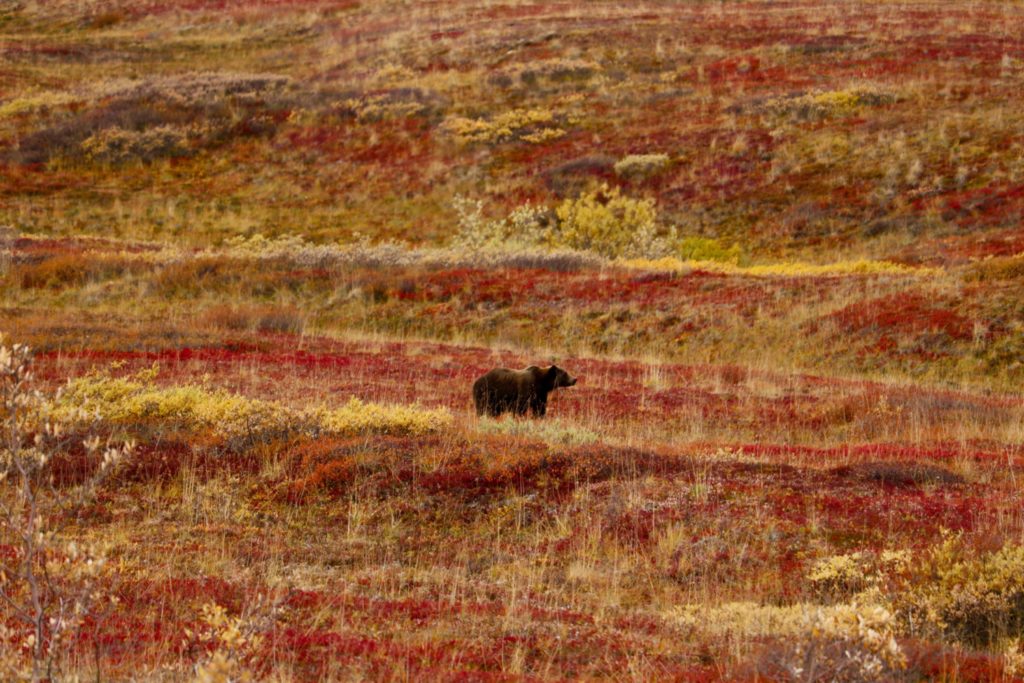It’s just a fact that you will most likely at least see a grizzly bear on your trip. In most cases, bears are not a threat, but they do deserve your respect and attention. When traveling in bear country, keep alert and enjoy the opportunity to see these magnificent animals in their natural habitat. However, it’s entirely possible that you’ll be forced into circumstances where dealing with bears becomes necessary, and you need to be prepared.
- If you surprise a bear at close distance, it may feel threatened and act defensively, especially if it has cubs or food. Continue to stand your ground. If the bear moves away, walk away slowly, keeping your eyes on the bear. Increase your distance.
- NEVER RUN FROM A BEAR! You can’t outrun a bear. Bears can run much faster than a sprinter and, like dogs, they will chase fleeing animals. A charging bear might come within a few feet before running off. It’s important to stand your ground.
- Most grizzly and brown bear attacks are a defensive response. Play dead in defensive situations: Hit the ground and lie still if a brown bear you have surprised or any female bear protecting cubs makes contact. Lie flat on your stomach, legs spread apart for stability, with your hands protecting the back of your neck. A defensive bear usually ends its attack if it feels you are not a threat. Remain motionless for as long as possible. If you move, and the bear sees or hears you, it may return and renew its attack. In a prolonged attack, fight back.
- Fight back in other situations: Rarely, lone black bears or brown bears may perceive a person as potential food. Fight any bear that has been calmly focused on you and makes contact or that breaks into a tent or building. In almost all situations, your best defense against an attacking black bear is to fight back. Concentrate on the bear’s face or muzzle with anything you have on hand.
Bear Deterrents
If you see a bear, avoid it and give the bear every opportunity to avoid you. If you do encounter a bear, remain calm and try to observe what the bear is doing. Chances are good you are not in danger. Most bears are interested only in protecting food, cubs or their “personal space.” Once they feel there is no threat, they will move on.
Remember the following:
- If the bear appears not to have sensed you, move away without alerting it. Keep your eyes on the bear.
- If the bear does notice you, face the bear, stand your ground and talk to it calmly. Let the bear know you are human. Talk in a normal voice. Help the bear recognize you. Try to appear larger by standing close to others in your group or wave your arms slowly above your head. Try to back away slowly, but if the bear follows, stop and hold your ground. Prepare your deterrent if you have one.
- If a bear cannot tell what you are, it may come closer or stand on its hind legs to get a better look or smell. A standing bear is usually curious, not threatening.
- If you take the above actions and the bear continues to focus on you or approach, you should become more assertive: raise your voice, beat on pans, use noisemakers, throw rocks or sticks. Use your deterrent if you have one. Drive a bear off rather than let it follow you. If you are with others, group together to look big and stand your ground.
If a bear makes contact, you have two choices: play dead or fight back.
The best choice depends on whether the bear is acting defensively or is seeking food. There are two schools of thought for dealing with bears: use a firearm, or carry bear spray. Each hunter has to make a personal choice.
Firearms
Firearms are the best defense against bears, and whatever rifle you’re hunting with should be sufficient. However, lots of people also carry a handgun.
Bear Spray
Bear spray is not permitted in checked or carry on baggage in commercial flights, and charter operators have strict rules about the transport of this potentially dangerous material. We will have bear spray available for RENT or PURCHASE at the hangar.
Bear spray is effective, but it doesn’t work well in the wind or heavy rain, which happens frequently. The downside to bear spray is you can’t take it on an airline; no bush pilot wants it inside the cabin either. Check with your transporter to see if you can get the spray where you are hunting, and if they will fly with it.
Products labeled as bear spray contain capsicum (red pepper extract) and are effective at deterring bears at close range. Bear sprays are designed to propel a mist for 15 to 30 feet. If discharged upwind or in a vehicle, they can adversely affect the user. Take appropriate precautions. If you carry bear spray, keep it handy and know how to use it.
How to Avoid a Bear Encounter
Bear deterrents, including firearms and bear spray, can be helpful but should never be used as an alternative to common-sense approaches to bear encounters. While most bears want nothing to do with people, you still have to be prepared to deal with them.
- Make noise so you don’t surprise a bear. Stay alert and look for signs of bears.
- Never approach or crowd bears; respect their “personal space.”
- Keep food, garbage and other attractants out of reach of bears.
- Be careful dressing and packing game, and keep meat 100 yards or so downwind of camp.
- Stay calm during a bear encounter. Ready your deterrent. Stand your ground, group up with others and alert the bear by talking calmly. Don’t run.


